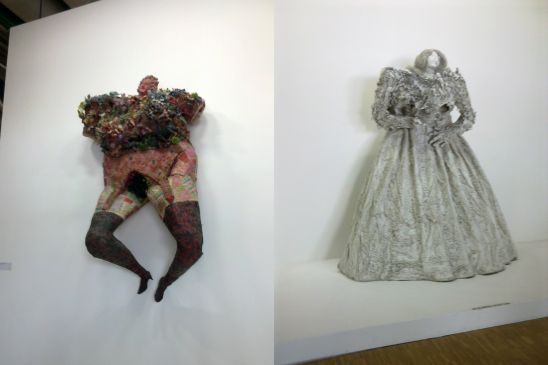Sex, Violence, and Vulgarity: Reclaiming the Female Body in French Art

For travelers seeking an interlude from active life in the form of life on canvas, look no further than the Centre Pompidou in Paris. But beware: the concept of the current exhibition, ‘Women Artists’ (Artistes Femmes), is neither for the faint of heart nor for the faint of stomach. Installed in May 2009, many of the pieces, which include painting, sculpture, mixed media, photography and video, are sexually charged, violent and vulgar. This isn’t an insensitive analysis. In fact, the significance of the work is embodied in its aesthetic crudeness-the pieces reveal women exploring their bodies in ways that only men have previously done, and thus reclaiming their figures and bodily experiences.
The exhibition is divided into eight themes, but the overriding objective in all of the pieces is the art of redefinition. Until several decades ago, art created by women was largely unrepresented in major museums. Thus, the concept of devoting an exhibition exclusively to women is by nature redefining the world of modern art: grabbing the audience, shaking it by the shoulders, and exclaiming: yes, women can do that too…
The oeuvres I found most stimulating were those that did not shy away from abrasive or shocking images. One example is Francoise Janicot’s photograph “L’enconnage” (Sexual Act), displayed in the Corps Slogan (Activist Body) section, which shows a human head wrapped entirely in string, the skin and facial features masked. According to an explanation, the piece depicts Janicot herself tied up, a commentary on the difficulties of being at once a mother, wife and artist in the 1970s. In using physical discomfort to convey the woman’s role at that time, she elicits empathy in the viewer.
Other, much more explicit pieces included my personal favorite, Evelyne Axell’s “Le Retour de Tarzan” (“The Return of Tarzan”), completed in 1972 and displayed in Feu Volonte (Free Fire). This piece was inspired by pop media featuring bright neon colors and images which are layered, so that certain facets of the piece seem to be raised from the rest of the work. The woman is in the foreground, lying with her nipples exposed and caressing a docile lion and a ‘slippery fish sliding between her legs’ (as the plaque erotically informs the viewer).
A blog about Axell and “Le Retour de Tarzan” (http://elles.centrepompidou.fr) describes her artwork as “modernity relying on her body-on the pleasure derived from an active female sexuality…[using] radical employment of the pin-up-pop culture’s misogynist staple of the sexual woman-in its most pornographic manifestations…as an emblem of active female sexuality.”
Whereas the first piece is Janicot’s dialogue with herself-a tangible depiction of the pressure she felt while trying to juggle several societal roles in a society that did not credit her trials, the second piece is Axell’s effort to reclaim the female body for women in general. While men have been exploring the female body physically and visually through art for centuries, women have contributed little to their own image. Since the conception of Christianity, the woman has been viewed as malicious and deceptive, the cunning Eve to the unassuming Adam (or else the ‘just play dumb’ Adam who’s slipping you GHB at the bar). Axell’s piece colorfully and poignantly suggests that women are in fact no higher or lower than men, they want sex too-but more importantly, they know when they want it.
These images of violence, discomfort and flagrant sex are rarely images that women willingly use in self-descriptive art. Yet, in this exhibition, women artists reclaim and redefine their bodies, societal roles, and sex in art as a femaleexperience and not merely one imposed upon females by men and a patriarchal arrangement. By reshaping social dialogue, these artists give the woman’s perspective an active voice.
Photo by by claire.








